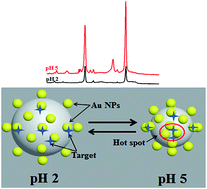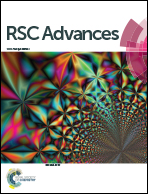Creating dynamic SERS hotspots on the surface of pH-responsive microgels for direct detection of crystal violet in solution†
Abstract
A systematic study for the creation of dynamic surface-enhanced Raman scattering (SERS) hotspots is reported. Herein, gold nanoparticles-loaded pH-responsive poly(2-vinylpyridine) (AuNPs/P2VP) composite microgels were prepared efficiently by in situ chemical reduction. The nano-gap among AuNPs could be tuned easily by changing pH values of AuNPs/P2VP microgels solution from 2.0 to 5.0, creating vast SERS hotspots for electromagnetic enhancement. This change increased the SERS intensity remarkably, using 4-mercaptobenzoic acid (PMBA) as the model probe at a concentration of 1 × 10−4 M. Besides, the strongest SERS signal of PMBA was obtained when the gold concentration was 0.6 g L−1, and we systematically studied the relationship between gold concentration of AuNPs/P2VP microgels solution and SERS signal strength. The prepared SERS substrate with the strongest SERS signal was proved to be stable for months. Finally, the new SERS substrate was used for direct detection of crystal violet in solution, considering that crystal violet is the main ingredient in dye wastewater, and the detection limit was about 4 × 10−9 M. This result indicated that the new AuNPs/P2VP microgels are highly effective and can be used as a SERS-active substrate for direct analysis of a variety of objects in solution.



 Please wait while we load your content...
Please wait while we load your content...